Happy Birthday Governor Stanford!
Leland Stanford, president of the Central Pacific Railroad at the same time he served as California’s eighth governor, was born in Watervliet New York on March 9, 1824.
Elected in 1861, Stanford was California’s first Republican governor, the second of the state’s Civil War governors and the best known of those who held the office during the 19th century.
He was elected U.S. Senator in 1885, a job he surrendered with his death eight years later.
Six feet and 250 pounds, Stanford cut an imposing if somewhat dour figure. He was a stiff and, as one historian put it, uninspiring public speaker, happier at groundbreakings or social events.
“Not easily excited nor over sanguine in temperament, he readily grasps large schemes and usually works out his plans to a successful consummation,” write’s Oscar Shuck in Representative and Leading Men of the Pacific, published in 1870, a year after Stanford hammered the golden spike where his Central Pacific Railroad met the Union Pacific at Promontory Utah.
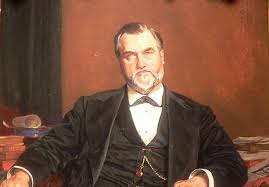 Stanford was California’s last two-year governor. During his tenure, the state constitution was amended to create four-year terms for governors and other statewide office holders. Senate terms were also extended to four years and the terms of Assembly members doubled from one to two years.
Stanford was California’s last two-year governor. During his tenure, the state constitution was amended to create four-year terms for governors and other statewide office holders. Senate terms were also extended to four years and the terms of Assembly members doubled from one to two years.
In part due to the Civil War, California prospered during Stanford’s time as governor, allowing the state’s debt to be cut in half.
Nonetheless Stanford told lawmakers in his first annual message that California’s finances “are in a condition, to say the least, far from flattering.”
Throughout his term, Stanford was an ardent advocate of the railroad he and his business partners – Charles Crocker, Mark Hopkins and Collis Huntington – were building.
He touted the railroad in his annual messages to lawmakers and numerous other speeches.
“The great work of the age,” he called it in his inaugural address.
Using a silver spade, he turned the first earth of the railroad at the bottom of K Street in Sacramento on January 8, 1863. He predicted completion by 1870.
FROM NEW YORK TO CALIFORNIA
Stanford didn’t come to California until 1852.
The fourth of seven sons, Amasa Leland Stanford, grew up in New York, entering an Albany law firm in 1845.
Admitted to the bar in 1848, he moved to Port Washington, Wisconsin and set up a law practice. His father, Josiah, presented him with a law library.
He returned to Albany briefly to marry Jane Elizabeth Lathrop, who, at 39, gave birth to their only son Leland DeWitt Stanford in 1868. (The child later asked to called Leland Stanford Jr.)
A fire raged through Port Washington in March 1852, destroying Stanford’s law office and library, valued at $3,000.
In financial straits, Stanford elected to join his brothers who had already succumbed to the gold fever and moved to California. He arrived in San Francisco aboard the steamer “Independence” on July 12, 1852.
Stanford stayed for a short time with his brothers, who had given up prospecting for mercantilism, then opened a store in Cold Springs in El Dorado County.
The gold at Cold Springs played out soon after Stanford arrived and he moved his store to Michigan Bluff in Placer County.
There, Stanford was elected Justice of the Peace and served in that capacity until May 1855 when he sold his interest in the store and returned to Albany to be with his wife following the death of her father.
It was the only elected post he held prior to becoming governor.
The couple returned to California together in the fall of 1855.
Stanford took over the ownership of the Stanford Brothers Warehouse in Sacramento on K Street between 2nd and 3rd. The neighboring business was a hardware company owned by Collis Huntington and Mark Hopkins, two other transplanted upstate New Yorkers.
The structure remains in Old Sacramento and is known as the “Big Four Building.”
MINING & CREATION OF THE REPUBLICAN PARTY
Stanford was briefly a resident of Sutter Creek after receiving an interest in what was then called the Union Mine as payment for a debt.
The mine, renamed the Lincoln, was losing money so Stanford traveled to Sutter Creek to work the claim.
There was no improvement. Stanford decided to sell the mine for $5,000 – if he could find a buyer.
Robert Downs, the mine foreman, persuaded Stanford to give the mine one last chance and within a year a major vein was tapped, producing $2.2 million in gold between 1860 and 1873.
Stanford eventually sold his interests for $400,000.
Stanford, Huntington, Hopkins and brothers Charles and Edwin Crocker were founders of California’s Republican Party, working for the election of John Fremont in 1856, the party’s first presidential candidate.
Stanford was an original trustee of the Sacramento Library Association but failed to win election as alderman in 1857 or state treasurer after receiving his party’s nomination later that same year.
But in 1859, Stanford got the GOP nod for governor – only after several more notable candidates backed out.
“I’m in favor of a railroad and it is the policy of this state to favor that party which is likely to advance their interests,” he said in his acceptance speech.
He spoke in Sacramento and San Francisco, barnstormed the Mother Lode but, on Election Day, he received the least votes of any candidate.
He campaigned for Lincoln in 1860 and journeyed to Washington to meet with the newly elected president to discuss the parceling out of federal jobs in the Golden State.
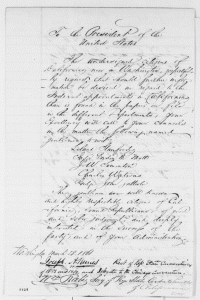
As the new president of a new party, Lincoln was besieged by job seekers looking for “patronage.”
There were plenty of opportunities in California. At the time, the U.S. Treasury Department alone had 150 jobs in the state including customs collector with a comfortable annual salary of $7,900.
Stanford, who sought no federal job, had his name placed at the top of a list of five Californians on a petition – endorsed by Lincoln – that authorized them to aid in the filling of federal posts.
“The undersigned citizens of California now in Washington respectfully request that should further information be desired in regard to the Federal appointments in California than is found in the papers on file in the different departments, your Excellency will call to your counsels in the matter the following named gentlemen,” read the petition, presented March 28, 1861.
“These gentlemen are well known and highly respectable citizens of California, sound Republicans, of good and sober judgment and deeply interested in the success of the party and of your administration.”
At the 1861 Republican convention in Sacramento, Stanford asked for his party’s nomination for governor and won it handily on the first ballot.
The election, he said, was a struggle of (Northern) democracy against (Southern) aristocracy – a theme he also sounded in is inaugural speech.
“We know today there would be no armed resistance and unlawful appeal from the will of the majority, convulsing the country, had the minority been possessed of proper information as to the objects and purposes of the majority,” Stanford said on January 10, 1862 in his inaugural address.
“It was this want of correct information among the masses where this most iniquitous rebellion that now troubles the land first found foothold, that caused the people in those sections to become the willing though blind instruments to serve the purposes of the selfish and aristocratic sentiment that would destroy our republican government.”
From the end of June until Election Day on September 2, Stanford stumped Northern California, extensively canvassing the mining regions.
His victory was aided by the pro-South Democrats and the pro-Union Democrats each nominating gubernatorial candidates. Between them, the two Democrats had 63,816 votes.
Stanford won with 55,935, making him a minority chief executive – just like his president.
CALIFORNIA’S EIGHTH GOVERNOR
On Stanford’s January 10, 1862 inaugural day, flood waters blanketed Sacramento – as well as other parts of the state – forcing the governor-elect to step out of the second floor window of his home at 800 N Street and be rowed to the temporary Capitol, the county courthouse at 7th and I Streets, for his oath of office.
Conditions were bad enough that the Capitol was temporarily moved to San Francisco.
The following year, Stanford labeled the disaster “a calamity unprecedented in the annals of California” in his January 7, 1863 message to lawmakers.
“A succession of floods were sweeping over and around us, visiting in their remorseless fury every corner of the state—covering our farms, and surrounding our farm houses, with their rising tide—rushing with a like impetuous torrent through the rugged canyons of Siskiyou, and over the vine-clad plains of Los Angeles.
“No section was exempt from their terrible devastation and no community was free from the general gloom that awaited the receding waters. Mines were flooded, farms were desolated, bridges were swept away and roads were ploughed up by the surging element.
“But vast as was the peril, and destructive the character, of these repeated disasters, the recuperative energies of our people have surmounted, for the most part, their devastating effects.
“The Legislature of the present year represents a state, not only recovered from the desolation of a year ago, but absolutely richer in population and wealth — in mineral, agricultural and manufacturing resources.”
The floods also delayed further construction of the state Capitol building until August of 1862. While groundbreaking occurred in December of 1860, construction had been in fits and starts using whatever money the Legislature approved during its biennial two-month sessions and halting when that appropriation was exhausted.
In his last message to lawmakers in December 1863, Stanford proposed the sale of bonds to speed construction of “ a structure that the future will be proud of” surrounded by an “ample park.” The land to create that park could “be had at acomparatively nominal sum,” Stanford said, “and the peculiar salubrity of our climate would, in a few years, surround the edifice with a beauty and luxuriousness that no other capitol in the country could boast.”
It appears from the Capitol Museum’s website, such a financing structure was not adopted. Although first occupied in 1869, the building wasn’t completed until 1874.
Stanford’s sentiments were quite different shortly after he left office when, after two years of construction, only 50 miles of Central Pacific track had been laid. Central Pacific needed 5,000 workers to take the rail line through the Sierras but had only 600 on the company payroll in 1864.
Chinese laborers, who had helped build the California Central Railway, were hired at $28 per month to blast tunnels and lay track through the high mountains. By summer 1868, 4,000 workers – two-thirds of them Chinese – succeeded in building a railroad that rose 7,000 feet in 100 miles and came down into the Central Plains beyond.
“A large majority of the white laboring class on the Pacific Coast find more profitable and congenial employment in mining and agricultural pursuits, than in railroad work. The greater portion of the laborers employed by us are Chinese, who constitute a large element in the population of California. Without them it would be impossible to complete the western portion of this great national enterprise, within the time required by the Acts of Congress,” Stanford wrote in an October 10, 1865 progress report to the President and the Secretary of the Interior.
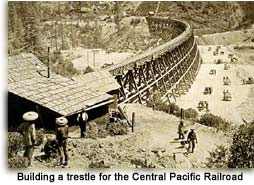 “As a class they are quiet, peaceable, patient, industrious and economical—ready and apt to learn all the different kinds of work required in railroad building, they soon become as efficient as white laborers. More prudent and economical, they are contented with less wages. We find them organized into societies for mutual aid and assistance. These societies, that count their numbers by thousands, are conducted by shrewd, intelligent business men, who promptly advise their subordinates where employment can be found on the most favorable terms.
“As a class they are quiet, peaceable, patient, industrious and economical—ready and apt to learn all the different kinds of work required in railroad building, they soon become as efficient as white laborers. More prudent and economical, they are contented with less wages. We find them organized into societies for mutual aid and assistance. These societies, that count their numbers by thousands, are conducted by shrewd, intelligent business men, who promptly advise their subordinates where employment can be found on the most favorable terms.
“Their wages, which are always paid in coin, at the end of each month, are divided among them by their agents, who attend to their business, in proportion to the labor done by each person. These agents are generally American or Chinese merchants, who furnish them their supplies of food, the value of which they deduct from their monthly pay.
“We have assurances from leading Chinese merchants, that under the just and liberal policy pursued by the company, it will be able to procure during the next year, not less than 15,000 laborers. With this large force, the company will be able to push on the work so as not only to complete it far within the time required by the Acts of Congress, but so as to meet the public impatience.”
As governor, Stanford signed legislation creating savings and loans as well as, on May 2, 1962, a bill creating the state’s first normal school – a college that trains teachers. It became San Jose State University.
Legislation to allow Sacramento’s incorporation was vetoed by Stanford because most of the affected citizens opposed it.
He also vetoed a move to take $100,000 form the Swamp Land Fund and use it to pay the salaries of the Legislature and its staff.
Stanford feared the cash-starved general fund couldn’t repay the swamp fund, which contained the proceeds from the state’s sale of such lands. An 1850 federal law gave states the ownership over all swampland within its borders.
Lawmakers overrode his veto.
Stanford was the first governor to call for state ownership of California’s forestlands, urging lawmakers in his inaugural speech to petition Washington D.C. to relinquish their control.
Like his predecessors, he was not satisfied with the performance of the state prison, which had undergone a variety of repairs and improvements during Stanford’s first year in office.
“But with all these improvements,” he told lawmakers in January 1863, “the state prison is far from being such an institution as a great state like this should possess.
“In its reformatory character it is an utter failure, in consequence of the necessity of confining a great number of prisoners in a single room – and in a limited space.
“The oldest, most experienced, and most hardened in crime, associate with those who are comparatively uncorrupted, and with those for whose reformation there might be reasonable hopes.
“In this way, the whole community within those walls tends strongly to a common and corrupt level of depravity. This condition of affairs can only be remedied by an increased number of cells.”
His inaugural speech mentioned the importance of his railroad — just as his subsequent messages to lawmakers did.
While direct financial support from the federal government wasn’t necessary to complete the rail line, Stanford allowed as to how having the government “donate lands and loan its credit” didn’t seem too much to ask.
In his last message to lawmakers, Stanford credited the previous Legislature for its “sagacity” in approving an appropriation to speed the railroad’s progress.
No natural obstacles stood in the way of the line reaching California’s eastern border within two years, Stanford said, just “possession of pecuniary means.”
Despite increasing taxes in 1862, the state’s treasury still felt “the pressure of outstanding obligations,” Stanford reported in December 1863.
In the same message to lawmakers, he said there was a “gratifying decrease in the floating indebtedness of the state,” however.
As he had called for at the beginning of his term, Stanford again advocated for an overhaul of California’s law books.
“Citizens not versed by constant familiarity with their contents and desirous of investigating the laws, stand aghast as they survey the 14 ponderous tomes that constitute the statues of this youthful state, and young aspirants to professional fame tremble as they cross the threshold that leads into this intricate abyss.”
There was plenty of anti-Confederate jingoism during Stanford’s last year in office. It became a misdemeanor to display a Confederate flag. Lawyers and public school teachers were required to take a loyalty oath.
A Union victory was assured in the Civil War, he told lawmakers in the conclusion of his last annual message, and “by the unquestioned triumph of right, we shall be able to look forward to a future of internal peace and public prosperity, and a growth in power and in the elements of greatness that will make the name of American citizen the proudest title that can be conferred upon a man.”
AFTER THE GOVERNORSHIP
In 1863, Frederick Low challenged Stanford for the nomination of his party. When Low gained momentum, Stanford withdrew from the race and returned to private life.
After leaving office, Stanford joined his friends Hopkins and Crocker and D.O. Mills, another Sacramento entrepreneur, in forming the Pacific Union Express Company in 1868.
Two years later, Pacific Union merged with Wells Fargo. Stanford was one of the directors of the new company from 1870, with a brief hiatus, until his death in 1893.
He moved to San Francisco in 1874 to become president of the Occidental & Oriental Steamship Co., a Central Pacific affiliate that linked California and the Far East.
He also built what was then the largest private residence in the state at the east half of the vacant block bounded by California, Pine, Powell, and Mason streets:
Nob HIll.
Destroyed in the 1906 earthquake, the site is now occupied by the Stanford Court Hotel.
Stanford’s home wasn’t the only edifice on nob Hill. Hopkins, huntington and Crocker built homes there as well.
“Comodious and elegant,” the mansion had a fresco-filled entry hall, 25 bedrooms, an elevator, a grand staircase and a rotunda with 16 Corinthian columns.
“The depot and offices of the Central Pacific Railroad are in full view from the southern windows,” the San Francisco Chronicle reported on February 7, 1875.
Gushed the Daily Alta Calfiornia on April 7, 1876: “though the dwelling of a private gentleman, the Stanford Mansion is as purely a high work of art as a great historical picture and as such is an honor and a glory to our city to have it in its midst.”
Stanford could afford the opulence. By that time, in 2010 dollars, he was a billionaire.
Among Stanford’s other holdings were two wineries, one in Alameda County run by his brother Josiah and another in Tehama County.
His 650-acre horse farm in Palo Alto became Stanford University, founded in memory of his son who died of typhoid fever in Florence Italy 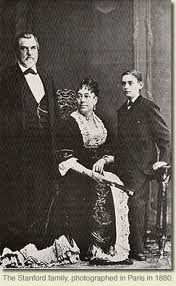 in 1884 at the age of 16. Among the members of the university’s original class of 1891 was future president Herbert Hoover.
in 1884 at the age of 16. Among the members of the university’s original class of 1891 was future president Herbert Hoover.
In 1872, Stanford hired photographer Eadwerd Muybridge to settle the question of whether all four hooves of a trotting horse leave the ground at once. It took Muybridge several tries but his famous study — “The Horse in Motion” — shot in Sacramento and featuring Stanford’s horse Occident showed that indeed all four feet leave the ground simultaneously.
It and similar high speed photographic studies by Muybridge were forerunners of the motion picture.
As a senator, Stanford chaired the Committee on Public Buildings & Grounds. He opposed the Interstate Commerce law, which was aimed at tightening regulation of railroads.
He died of heart failure on June 21, 1893 and is buried with his son and his wife, who died in 1905, in the family mausoleum on the Stanford University campus.
-30-
Filed under: California History
Capitol Cliches Conversational Currency Great Moments in Capitol History News Budget and Economy California History Demographics Fundraising Governor Legislature/Legislation Politics State Agencies
Opinionation Overheard Today's Latin Lesson
Restaurant Raconteur Spotlight Trip to Tokyo Venting Warren Buffett Welcome Words That Aren't Heard in Committee Enough

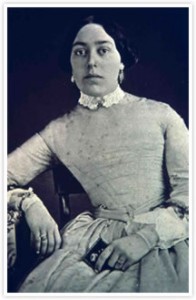


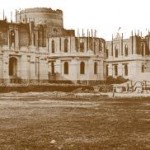
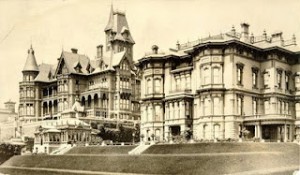
No comments yet.
RSS feed for comments on this post.